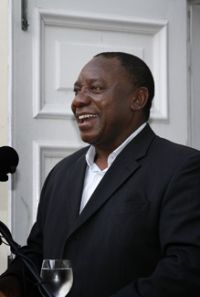
Cyril Ramaphosa.
(Image: Iziko Museums of Cape Town/Carina Beyer)February 17, 2010 – Two major exhibitions, Mandela: Character, comrade, leader, prisoner, negotiator, statesman; and Drawing on Madiba by Zapiro, opened at the Iziko Museums’ Slave Lodge in Cape Town on February 10, 2010, on the eve of the 20th anniversary of Nelson Mandela’s release from prison, on February 11, 1990.
Guest speaker, Cyril Ramaphosa, delivered the keynote address at the opening.
Here is the keynote speech, as delivered by Ramaphosa at the exhibition.
“Programme Director,
Ladies and Gentlemen,
It is a great honour for me to have been invited to speak at the launch of these two exhibitions, honouring and recalling the great contribution of Nelson Mandela to our people and to the peoples of the world.
It is particularly significant that this event is being held to coincide with the 20th anniversary of his release from prison.
It is fitting that this important day in the history of our nation should have been chosen for the annual State of the Nation address by the President. It helps to put into perspective the tasks of the nation in 2010, and reminds us of how far we have come.
I am pleased that so many of the people who were involved in those crucial events are able to be here this evening. Their stories and their recollections are essential for ensuring that we do not forget how this democratic nation came into existence.
Let us cast our minds back 20 years, to February 10, 1990, the evening before Madiba was to walk free from Victor Verster Prison.
It was little over a week since the unbanning of the ANC, PAC, SACP and other organisations. Though we understood that momentous changes were taking place, it was impossible to grasp exactly how, and in what way, our country would change.
As we prepared for the release of Mandela, there were great expectations. But there was also great uncertainty.
We made the practical arrangements for Madiba’s release. We made plans for where he would speak, how he would travel, where he would stay.
But we really had no idea what would happen the day after.
We had no idea how the country would respond or how the conservative elements in our society would react.
Did this indeed herald the beginning of a negotiated transition, or was it merely another ploy to further delay the liberation of our people?
These were questions to which none of us had answers.
And what of the man himself?
In truth, the thousands of people who turned out to greet him knew very little about the real Nelson Mandela. They knew him as a symbol, as a representation of the struggle of the South African people. They had heard the stories about him. They may have read his statement from the dock.
But it was far from certain whether the man would live up to the myth.
After 20 years, we now know the answer.
In truth, Mandela the man fast surpassed Mandela the myth.
We were delighted, and somewhat relieved, that what we had been told about Mandela was indeed true.
We must pause here to pay particular tribute to the person who was perhaps most instrumental in promoting Nelson Mandela as the symbol of our struggle – his comrade, friend and law partner, Oliver Tambo.
More than anyone else, Oliver Tambo recognised the value to our struggle, both internationally and at home, for the release of Nelson Mandela to become a rallying point.
Through these efforts, he was able to ensure that from New York to Sydney, from Accra to Moscow, the citizens of the world were demanding a free Mandela.
That cry, ‘Free Mandela’, became shorthand for the broader call to end apartheid and to establish in South Africa a non-racial democracy.
The people understood that to free Mandela would necessarily require steps to free the people of South Africa.
That much was acknowledged by Madiba himself, in 1985, when he told the people of South Africa:
‘What freedom am I being offered while the organisation of the people remains banned? What freedom am I being offered when I may be arrested on a pass offence? What freedom am I being offered to live my life as a family with my dear wife who remains in banishment in Brandfort? What freedom am I being offered when I must ask for permission to live in an urban area? What freedom am I being offered when I need a stamp in my pass to seek work? What freedom am I being offered when my very South African citizenship is not respected?.
‘I cannot and will not give any undertaking at a time when I and you, the people, are not free.
‘Your freedom and mine cannot be separated. I will return.’
The release of Nelson Mandela was not an isolated moment.
It wasn’t a miracle. Nor was it achieved out of the goodness of anyone’s heart.
It was the result of an all-round intensification of the struggle against apartheid through mass action and mass defiance, armed struggle, international isolation and diplomatic engagement.
It was one of a sequence of events that led from the crisis of the apartheid state to its demise, to the achievement of democracy.
It was not the moment that South Africa became free. Indeed, much violence, struggle and setbacks were still to follow.
But it was the day on which we knew for certain that nothing in South Africa would be the same again.
For this, we must pay tribute to the struggling masses of this country.
It was them that freed Nelson Mandela.
But we must also acknowledge those within the National Party government who had the foresight and courage to engage the banned organisations and to release political prisoners.
In the light of events that followed, particularly the intensification of state-sponsored violence, the release of Mandela could easily be dismissed as a tactical ploy that was part of a broader plan to neutralise the liberation movement.
Certainly there was an element of that.
But there was also a sincere recognition by some within the ruling class that the future of black and white South Africans was inextricably bound together.
Despite the best efforts of successive colonial and apartheid ideologues, the simple truth was that all South Africans shared a common destiny.
The question was whether it was to be a future of perpetual strife, or one of peace, stability and a shared nationhood.
Fortunately, for South Africa, the latter prevailed.
Ladies and Gentlemen,
As we prepared for Mandela’s release, on the evening of Saturday, February 10, 1990, could we have imagined where the country would be today?
Could we have imagined that we would be hosting the Soccer World Cup, the first African nation to do so?
Could we have imagined occupying a seat on the UN Security Council?
Could we have imagined the National Party and the ANC sitting together in an elected Constitutional Assembly to draw up one of the most progressive constitutions in the world?
We have much to celebrate about the last 20 years.
We must acknowledge that our country is fundamentally altered in so many respects.
For one, we are at peace with each other and the world.
We are a stable, thriving multi-party democracy. We have an independent judiciary, a bill of rights, a free press, an unfettered trade union movement.
Importantly, we have made significant progress in undoing much of the social and economical legacy of apartheid.
We managed to reverse the decline of the economy, restore stability and record a sustained period of growth.
We have managed to significantly reduce the level of public debt and shift resources towards meeting people’s basic needs.
We have undertaken the most extensive provision of housing, water, electricity, sanitation and other amenities in this country’s history.
With each passing year we make further progress in improving the lives of our people.
Even those who have yet to benefit from the provision of housing and other basic needs can be confident that they will soon be able to access these.
But still, poverty persists. Unemployment remains high. Despite progress, many people still have difficulty accessing education opportunities, or affording proper health care. Our communities are plagued by crime.
As we confront these challenges, it is right that we remember the day, 20 years ago, on which Nelson Mandela walked free.
Because in remembering that day, we remember we were able to overcome seemingly insurmountable obstacles.
We remember that we were able to bring down one of the most iniquitous political systems of the 20th century.
We should celebrate this day so that we are reminded of that which we are capable of when we are united, determined and focused.
Therefore, as we contemplate the tasks of this new decade, we must draw inspiration from that historic moment.
We should derive hope and sustenance from the example that Madiba has set.
We should redouble our efforts to eradicate poverty and suffering, to build our economy and create jobs.
We should do so, because the ultimate significance of the release of Nelson Mandela will not be realised until all South Africans are truly liberated from want and hunger and exploitation.
We should do so, so that we can give true meaning to the words of Nelson Mandela when he said: ‘Your freedom and mine cannot be separated.’
I thank you.”
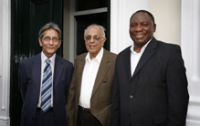
Achmat Dangor, Ahmed Kathrada, Cyril Ramaphosa.
(Image: Iziko Museums of Cape Town/Carina Beyer)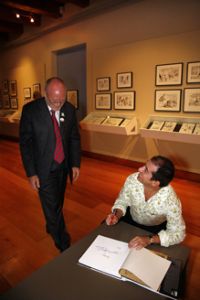
Derek Hanekom and Jonathan "Zapiro" Shapiro.
(Image: Iziko Museums of Cape Town/Carina Beyer)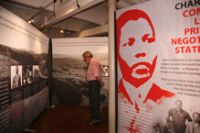
Museum display.
(Image: Iziko Museums of Cape Town/Carina Beyer)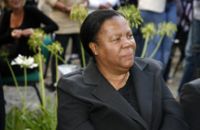
Naledi Pandor
(Image: Iziko Museums of Cape Town/Carina Beyer)